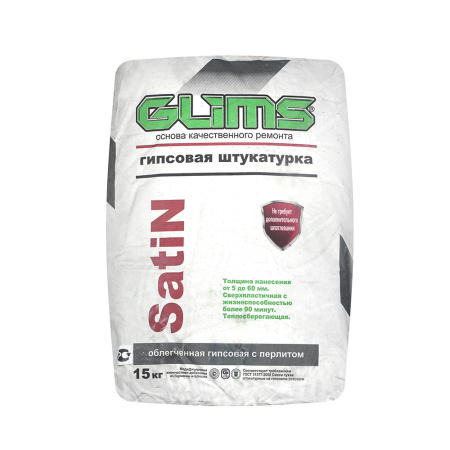Plaster mix for internal works in dry premises and premises with moderate humidity. Is applied to lower stratum made of autoclaved lightweight concrete and porous concrete, Ytong blocks, to the brick walls made of clinker bricks, loam bricks and sand-lime bricks, to porous ceramic blocks, to slag blocks, LECA blocks, polysterene-concrete blocks as well as to previously plastered surfaces.
ADVANTAGES
- For high-quality alignment of walls and ceilings for wallpaper hanging, painting and other types of finishing coatings in dry and humid premises, as well as for the manufacture of decorative fixtures
- Heat-saving
- Keeps increased application life
- Superplastic: is applied and leveled easily
- Does not need a lath
- It is smoothed out to shiny finish; it can be used without finish stopping filler
- Elastic, with increased crack resistance: does not crack upon drying out and use
- Moisture-resistant, can be used for bathrooms and sanitary conveniences
- It can be puttied or painted after 1-5 days (depending on layer thickness and humidity)
- Reliable and cost-efficient
- Maintains a comfortable indoor climate
- Environmentally friendly, nonhazardous in use and operation
- Complies with European standards
- (EN 998-1 Class CSII T2 W2)
SURFACE PREPARATION
When applying and hardening the finishing mortar the temperature of the lower stratum and the environment should not be lower than +5 ° C. The mortar is applied to durable, dry, dust free lower stratums. The lower stratum solidification process must be completed. Before applying it is forbidden to cover the surface with drying oil, soap, etc. It is recommended to remove highly absorbent, dusty and loose layers from the surface. The surface of site concrete, brick walls made of ceramic bricks, concrete and slag blocks must be preliminarily treated with adhesive primer GLIMS®БетоContact. The surface of brick walls made of sand-lime bricks, autoclaved lightweight concrete, LECA or old plastered surfaces are recommended to be twice treated with GLIMS®PrimeГрунт (“wet on wet”). The primers drying and polymerization period before applying the plaster is 24 hours at room temperature and normal humidity.
MORTAR PREPARATION
Manual method. Pour the package contents into a reservoir with clean water at a rate of 0.51-0.6 l of water per 1 kg of dry mix and mix thoroughly with a mixer or drill with a nozzle to even consistency. Keep the resulting mixture for 5-7 minutes and mix it once more. It is necessary to use the mortar within 90 minutes. When thickening “revive” the mortar by mixing without addition of water. When applying plaster in thick layers it is recommended to use the minimum permitted amount of water to prepare the mortar.
Mechanical method. Pour the contents of the package into the receiving hopper of the plastering station, adjust the water flow to obtain a mortar mix of normal consistency: 0.5-0.6 l per 1 kg of dry mix. Operations with the plastering station should be carried out in accordance with the technical data sheet and the description of works.
SURFACE PLASTERING
Manual method. The resulting mortar mix is applied to the surface using a stucco hawk or trowel during 90 minutes after mixing, then it is leveled by the screed bar. The thickness of one layer should not exceed 60 mm. The second layer of plaster is allowed to be applied only after the complete drying out of the first one.
Mechanical method. The finished mortar mix is applied evenly to the lower stratum with an overlapping of about 5 cm. The flow coming out of the nozzle perpendicular to the lower stratum should lie on the wall as a "herringbone".
Screeding. Within 10-15 minutes from the time of application the mortar applied to the lower stratum surface must be evenly leveled according to pre-installed joint displacement indicator bars using the screed bar.
Undercutting. When the applied mixed plaster begins to set (approximately in 60-90 minutes after application), the surface can be leveled with a screed bar by undercutting. Keep the tool perpendicular to the lower stratum, striking off surplus material and filling the recessions with a fresh mortar.
Float finish. To prepare the surface for painting 60-90 minutes after screeding and/or undercutting it is possible to trowel the plaster with a sponge board abundantly wet with water. Following which, after waiting for the matt surface appearance, trowel the surface with wide metal putty spittle. Depending on the ambient humidity and temperature, as well as the thickness of the layer, the float finish time may vary.
Glazing. Within 24 hours, but not earlier than 3 hours after screeding and/or cutting, the plaster must be strongly moisted and smoothed thoroughly using a steel trowel, floater or putty spattle. After the treatment and final drying out, it is allowed to apply top coatings (wallpapers, painting, etc.) to such a surface without additional filling.
Additional recommendations. If it is necessary to achieve a perfectly smooth surface after applying the GLIMS®SatiN plaster, it is recommended to use GLIMS®Finish-LightRoom+ finish polymer filler or GLIMS® FinishGips finish gypsum filler. When used in sanitary conveniences, GLIMS® GreenResin or GLIMS® ВодоStop waterproofing materials should be used even after applying of GLIMS® SatiN plaster. It is forbidden to use dirty tools and containers for work, since this reduces the time of the compo mortar use. Addition of other components is not allowed. The temperature in the premise during operation and within 24 hours after completion should not be lower than + 5°C, after 24 hours after application it is recommended to provide ventilation of the plastered premises. While working it is necessary to observe the norms of SNiP and industrial hygiene.
CONSUMPTION: 0,8-0,9 kg/m2 per 1 mm of layer thickness.
PACKAGING: kraft paper bags 15 kg, 30 kg, plastic bags 5 kg.
TRANSPORTATION AND STORAGE
During transportation and storage, bags with dry mortar should be protected from damage and soaking. The storage period is 12 months from the date of production. Dry plaster on a gypsum binder 45/90/2,0. GOST 31377-2008. Radiation safety class - 1. TU 5745-010-40397319-2003 № 0370/3

